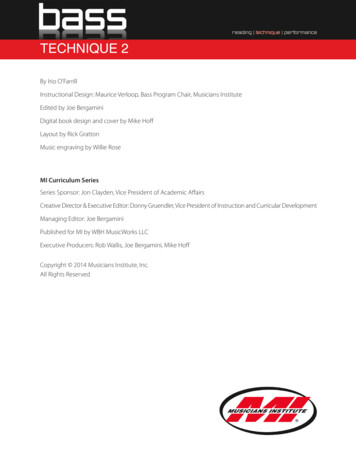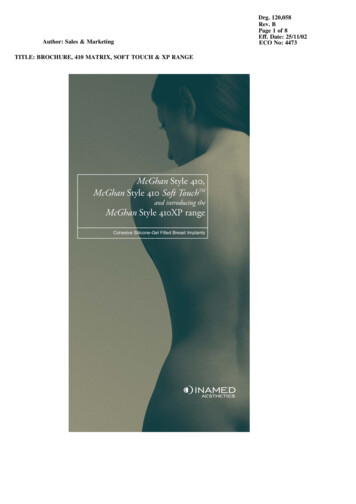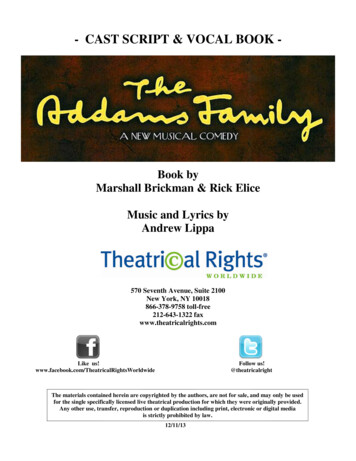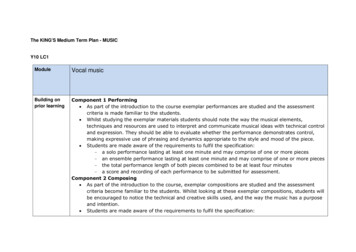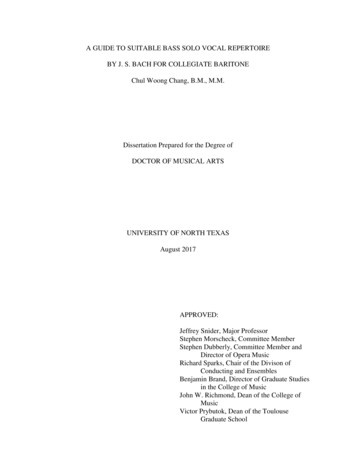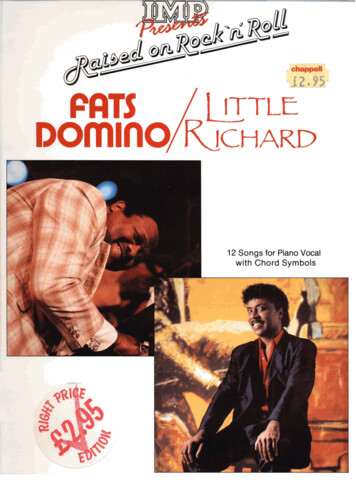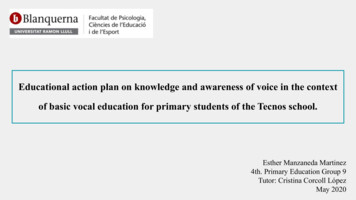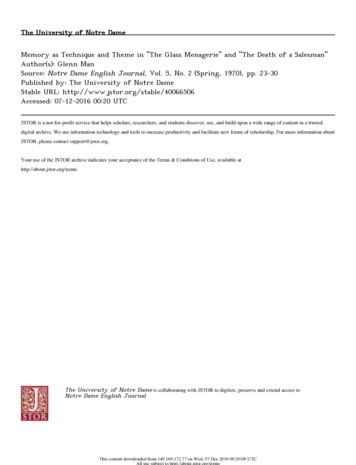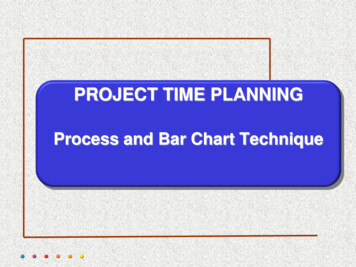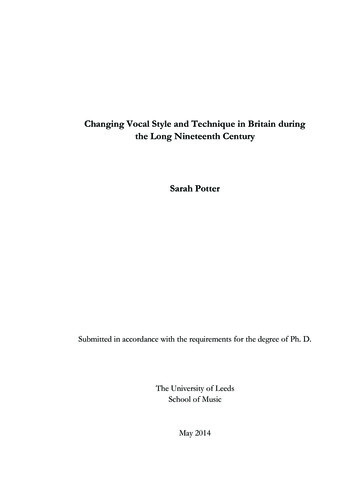
Transcription
Changing Vocal Style and Technique in Britain duringthe Long Nineteenth CenturySarah PotterSubmitted in accordance with the requirements for the degree of Ph. D.The University of LeedsSchool of MusicMay 2014
The candidate confirms that the work submitted is her own and that appropriate credit hasbeen given where reference has been made to the work of others.This copy has been supplied on the understanding that it is copyright material and that noquotation from the thesis may be published without proper acknowledgement.The right of Sarah Potter to be identified as Author of this work has been asserted by herin accordance with the Copyright, Designs and Patents Act 1988. 2014 The University of Leeds and Sarah Potter.
ACKNOWLEDGEMENTSFacilities and staff at the University of Leeds have been fundamental to the completion ofthis project, particularly those within the School of Music and at the Brotherton Library. Ihave received considerable support from Sue Wheater, Dave Barraclough, and PaulFawcett in the arrangement and facilitation of recording sessions in the Clothworkers’Centenary Concert Hall at the School of Music. There are numerous other members of thedepartment who have offered assistance and advice at one time or another; I am grateful toeach and every one, however incidental they might have thought these exchanges at thetime.Jude Brereton and Helena Daffern (York Centre for Singing Science, University ofYork) have generously shared their knowledge throughout the preparation of this thesis,and I am extremely grateful for the numerous hours of fruitful discussion and support theyhave freely volunteered. The expertise of Kerry-Anne Kubisa in recording, engineering andmastering the recorded element of this project has been invaluable to the completion ofthis research, as have the discussion and friendship that the process has nurtured. Thevalued contribution of Dan Gordon to the Record Portfolio has likewise been instrumentalto the success of the project as a whole.I am indebted to Professor Clive Brown and Dr Bryan White for the support andencouragement they have provided throughout this process. Particular thanks are due toboth Professor Brown and Dr David Milsom, without whose initial encouragement thisproject would never have been devised. This research was made possible by the award of aresearch scholarship from the Stanley and Audrey Burton Trust; support has also beenreceived from the Yorkshire Ladies’ Council of Education.Thanks are due to countless family members, and many friends (some of whom Iwould not have met but for this research project); their patience and understandingthroughout this project will not be forgotten. To my parents, in particular, I am thankfulfor early musical encounters and lifelong encouragement to succeed. I am especiallygrateful to my eldest sister, Anne, for receiving and answering frustrated phone calls andtext messages in times of stress. The greatest of thanks is due to my husband, Matthew,who has endured this research for better and for worse, and listened to far more earlyrecordings than he ever desired to.[i]
[ii]
ABSTRACTThis thesis presents an overview of solo singing styles and techniques prevalent in Britainduring the long nineteenth century, drawing upon evidence from didactic writing,correspondence, critical review, biography, voice science research, and early acousticrecordings in order to analyse changing approaches to voice production and musicalexpression. The discussion of vocal style is underpinned by discussion of a changingapproach to larynx height, and concepts of chiaroscuro, bel canto, and expression arereconsidered in the light of technical discussion. The origins of the continuous larynxlowering now expected of the modern operatic singer are recognised in early nineteenthcentury voice science literature, but notable trends in selective larynx-lowering areidentified from the mid nineteenth century onwards. This confirms the ideal of continuouslarynx-lowering as a twentieth-century development, and has significant repercussions forcurrent approaches to historically-informed performance and the singing of ‘early music’.The changing use of vibrato effects, portamento and messa di voce, and the application ofexpressive devices more generally throughout this period are considered within the contextof nineteenth-century approaches to voice production.This thesis is accompanied by a four-CD portfolio of recordings that demonstratesexperimentation with nineteenth-century styles and voice production techniques, theemulation of early recorded vocal performances, and the realisation of nineteenth-centuryrepertoire using historically-appropriate approaches to style and technique. Repertoireincludes didactic material, operatic arias (including those by ‘bel canto’ composers),repertoire annotated by renowned pedagogue Manuel Garcia II, and works sung bycelebrated nineteenth-century performers and early recording artists. Also included isexperimentation with audio filtering that seeks to emulate the limited frequency capture ofearly acoustic recording apparatus with a view to further understanding the evidence ofnineteenth-century voices on record.[iii]
[iv]
CONTENTSACKNOWLEDGEMENTSiABSTRACTiiiRECORDED PORTFOLIO TRACK LISTINGixINDEX OF ILLUSTRATIVE MATERIALxiNOTESxiiCHAPTER ONE:CHAPTER TWO :Reviving the Art of Singing: Project Outline11.1. Introduction11.2. Sources1.2.1. Printed1.2.2. Recorded1.2.3. Scientific56791.3. Research Methodology1.3.1. Recorded Portfolio10111.4. Thesis Arrangement12The Rise and Fall of the Larynx: Trends in VoiceProduction152.1. Neutral Larynx Usage162.2. Transitional Approaches to Larynx Height282.3. Searching for the Singer’s Formant2.3.1. Effect upon Volume40452.4. Breath Control2.4.1. How to Breathe2.4.2. Constriction and Restriction2.4.3. Where to Breathe2.4.4. Breathing as Articulation52525759632.5. The Concept of Bel Canto64[v]
CHAPTER THREE:CHAPTER FOUR:CHAPTER FIVE:Defects, Deviation, and ‘Good Singing’: The Discussionand Use of Vibrato Effects673.1. Semantics683.2. Pitch Variation: ‘Tremolo’733.3. Intensity Variation: ‘Vibrato’763.4. Vibrato as an Expressive Ornament813.5. Physiological Considerations853.6. Non-Vibrato Approach88‘The Soul of Music’: Messa di voce and Portamento954.1. Messa di voce4.1.1. Neutral Larynx Height4.1.2. Low Larynx Height4.1.3. Vibrato and the Messa di voce4.1.4. Notes on Usage95969798994.2. Portamento4.2.1. Definition and Notation4.2.2. Range and Speed4.2.3. Location of Portamenti4.2.4. Nature of Movement4.2.5. Types of Portamento4.2.5. Relationship to Legato4.2.7. Emotional Significance4.2.8. Notes on Usage102102103106107113117121124Sense and Sensibility: Further Requirements forAffective Nineteenth-Century Singing1295.1. Expression5.1.1. Ornamentation5.1.2 Tempo Variation5.1.3. Dynamic Variation5.1.4. Gesture in Vocal Performance129131133135137[vi]
CHAPTER SIX:CONCLUSIONPerforming the Art of Singing: Recorded PortfolioCritical Commentary1416.1. Larynx Height Experimentation: CD 16.1.1. Aims and Objectives6.1.2 Research Conclusions1411411426.2. Emulations of Early Recordings: CD 26.2.1. Aims and Objectives6.2.2. Performances Emulated6.2.3 Research Conclusions1461461461486.3. Frequency Experiments: CD 36.3.1. Aims and Objectives6.3.2. Research Conclusions1491491526.4. Misrepresented Repertoire: CD 46.4.1. Aims and Objectives6.4.2. Research Conclusions1551551556.5. Annotated Repertoire: CD 46.5.1. Aims and Objectives6.5.2. Research Conclusions1571571576.6. Additional Tracks: CD 4159A New Bel Canto: Towards Historically-InformedVocal Performances161169BIBLIOGRAPHY[vii]
APPENDIX A:Musical Texts: Editions and Transcriptions1831. Editions1832. Early Recording Transcriptions1852.1. Editorial Method2.2. Transcriptions186188Adelina Patti: Bishop Home, sweet home (1905)Nellie Melba: Bishop Home, sweet home (1905)Amelita Galli-Curci: Bishop Home, sweet home (1917)Adelina Patti: Mozart Voi, che sapete (1905)Nellie Melba: Mozart Voi, che sapete (1907)Nellie Melba: Mozart Voi, che sapete (1910)Blanche Marchesi: Chaminade L’été (1906)Emma Albani: Chaminade L’été (1914)Adelina Patti: Mozart Batti, batti (1904)Marcella Sembrich: Mozart Batti, batti (1904)Suzanne Adams: Gounod Jewel Song (1902/3)Marcella Sembrich: Gounod Jewel Song (1906)Nellie Melba: Gounod Jewel Song (1910)1891921951992032072112192242322392442513. Other Repertoire:Rossini Una voce poco fa from Il barbiere di SivigliaMadame Catalani: Cease your funningfrom Beggar’s OperaCimarosa Aria from Sacrifizio d’Abraham(annotated by Garcia)Crescentini Aria inserted into Romeo e Giuliettaby Zingarelli (annotated by Garcia)Morlacchi Aria from Teobaldo ed Isolina(annotated by Garcia)APPENDIX B:Recorded Portfolio: Production[viii]259260267269276281285
RECORDED PORTFOLIO TRACK LISTINGCD 1: Larynx Height Experimentation12345678910Vaccai Metodo Pratico Ex. VIII The Appoggiatura; NeutralVaccai Metodo Pratico Ex. XII Roulades (Runs); NeutralVaccai Metodo Pratico Ex. XIII Portamento Primo; NeutralVaccai Metodo Pratico Ex. XIII Portamento Altro Modo; NeutralVaccai Metodo Pratico Ex. XV Recapitulation; NeutralVaccai Metodo Pratico Ex. VIII; The Appoggiatura; TransitionalVaccai Metodo Pratico Ex. XII; Roulades (Runs); TransitionalVaccai Metodo Pratico Ex. XIII Portamento Primo, TransitionalVaccai Metodo Pratico Ex. XIII Portamento Altro Modo; TransitionalVaccai Metodo Pratico Ex. XV Recapitulation; 111112131415Mozart Ach ich fühl’s; Transitional (Erard)Mozart Ach ich fühl’s; Neutral (Erard)Mozart Ach ich fühl’s; Transitional (Steinway)Mozart Ach ich fühl’s; Neutral (Steinway)Mozart Ach ich fühl’s;Modern Low Larynx Operatic Vocal Standard (Steinway)3:183:234:014:014:42CD 2: Emulation of Early Recordings12345678910111213Adelina Patti: Bishop Home, sweet home (1905)Nellie Melba: Bishop Home, sweet home (1905)Amelita Galli-Curci: Bishop Home, sweet home (1917)Adelina Patti: Mozart Voi, che sapete (1905)Nellie Melba: Mozart Voi, che sapete (1907)Nellie Melba: Mozart Voi, che sapete (1910)Blanche Marchesi: Chaminade L’été (1906)Emma Albani: Chaminade L’été (1914)Adelina Patti: Mozart Batti, batti (1904)Marcella Sembrich: Mozart Batti, batti (1904)Suzanne Adams: Gounod Jewel Song (1902/3)Marcella Sembrich: Gounod Jewel Song (1906)Nellie Melba: Gounod Jewel Song 2:223:303:14
CD 3: Frequency Experiments1234Excerpt: Emma Albani: Chaminade L’été (1914); no filterExcerpt: Emma Albani: Chaminade L’été (1914); 100-4000HzExcerpt: Emma Albani: Chaminade L’été (1914); 100-2500HzExcerpt: Emma Albani: Chaminade L’été (1914); 150-2000Hz0:560:560:560:565678910111213Suzanne Adams: Gounod Jewel Song(1902/3); 150-2000HzMarcella Sembrich: Mozart Batti, batti (1904); 150-2000HzAdelina Patti: Mozart Voi, che sapete (1905); 150-2000HzMarcella Sembrich: Gounod Jewel Song (1906); 150-2000HzBlanche Marchesi: Chaminade L’été (1906); 150-2000HzNellie Melba: Gounod Jewel Song (1910); 150-2000HzEmma Albani: Chaminade L’été (1914); 150-2000Hz (complete)Amelita Galli-Curci: Bishop Home, sweet home (1917); 150-2000 HzMozart Ach ich fühl’s;Modern Low Larynx Operatic Vocal Standard; 150-2000 Hz2:223:373:443:304:063:162:124:434:42CD 4: Misrepresented Repertoire and Annotated Repertoire1234567Rossini Una voce poco fa from Il barbiere di Siviglia (1816)Bellini Ah! Non credea mirarti from La Sonnambula (1831)Donizetti Regnava nel silenzio from Lucia di Lammermoor (1835)Gounod Je veux vivre from Roméo et Juliette (1867)Bizet Je dis que rien ne m’épouvante from Carmen (1875)Verdi Ave Maria from Otello (1887)Puccini Vissi d’arte from Tosca (1900)5:273:194:043:485:373:563:318910Madame Catalani: Cease your funning from Beggar’s OperaCimarosa Aria from Sacrifizio d’Abraham (annotated by Garcia)Crescentini Aria inserted into Romeo e Giulietta by Zingarelli(annotated by Garcia)Morlacchi Aria from Teobaldo ed Isolina (annotated by Garcia)2:547:27117:565:22Additional Tracks121314Vocal Technique Example: Low Larynx HeightVocal Technique Example: Neutral Larynx HeightVocal Technique Example: ‘Spin’[x]0:150:140:11
INDEX OF ILLUSTRATIVE MATERIALILLUSTRATIONSChapter OneFigure 1: Illustration of cyclical research process11Chapter TwoFigure 2: Notation of full and half breath60Chapter FourFigure 3: Illustration of slurred and smooth sounds by Garcia (New Treatise )108Figure 4: Illustration of portamento in Novello’s Voice and Vocal Art (1859)111TABLESChapter TwoTable 1: Repertoire ranges23Appendix ATable 2: Symbolic representation of vocal performance practices186MUSICAL EXAMPLESChapter TwoExample 1: Taking breath before high notes61Example 2: Taking breath mid-word61Example 3: Frequent breathing61Chapter FourExample 4: Illustration of two forms of portamento by Garcia (New Treatise )[xi]115
NOTESReferencing in this thesis is based upon the MHRA (Modern Humanities ResearchAssociation) system. Additionally, in the main body of text the publication date of eachwritten source is included in brackets after the name of the author to assist with clarity andease of comprehension where both nineteenth-century and modern theorists are cited.Short titles are used where a publication date is unknown. Any additional emphasis inquoted text (italicisation, bold type) has been noted in the footnotes; all other emphasis isrepresentative of the source. Anonymous sources are listed in the bibliography sortedalphabetically by title.References to pitch use the Helmholtz system, as depicted below in octavesbeginning with C:[xii]
Chapter OneREVIVING THE ART OF SINGING:PROJECT OUTLINE1.1.INTRODUCTIONWithin the field of professional practice there currently exists an imbalance betweenexpectations of the instrumental performer in historically-informed performance, andexpectations of the singer in a comparable role. The modern instrumentalist is oftenexpected to perform using historical techniques and correspo
14 Mozart Ach ich fühl’s; Neutral (Steinway) 4:01 15 Mozart Ach ich fühl’s; Modern Low Larynx Operatic Vocal Standard (Steinway) 4:42 CD 2: Emulation of Early Recordings 1 Adelina Patti: Bishop Home, sweet home (1905) 4:46 2 Nellie Melba: Bishop Home, sweet home (1905) 4:19 3 Amelita Galli-Curci: Bishop Home, sweet home (1917) 4:43 4 Adelina Patti: Mozart Voi, che sapete (1905) 3:44 5 .
